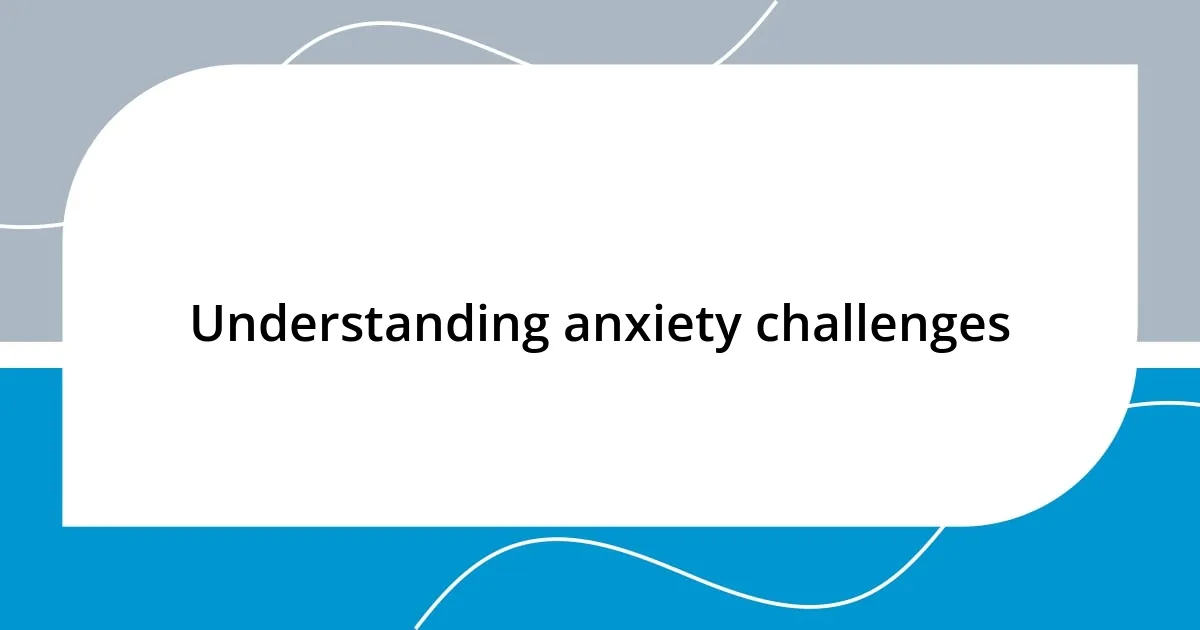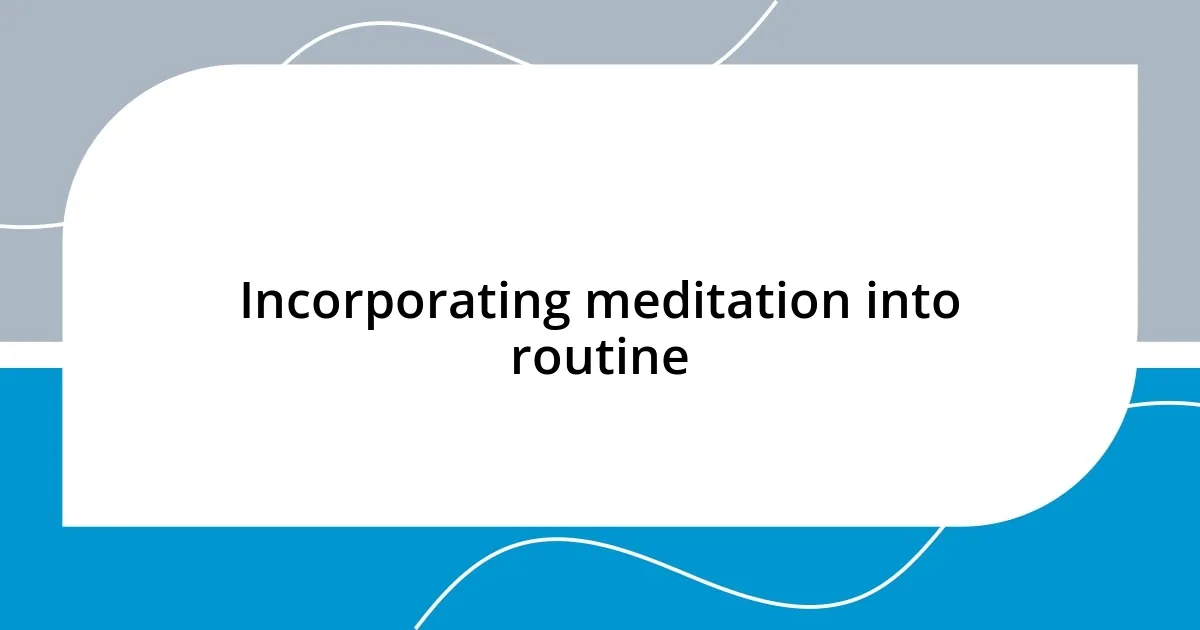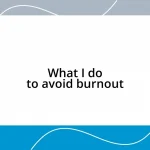Key takeaways:
- Anxiety can feel overwhelming and unpredictable, prompting a journey of introspection and understanding personal triggers.
- Mindfulness practices, such as breath awareness and body scans, help create a sense of calm and presence in the moment.
- Incorporating meditation into daily routines can yield significant improvements in emotional regulation and resilience against anxiety.
- Tracking progress and embracing setbacks as learning opportunities are essential for cultivating long-term benefits from mindfulness.

Understanding anxiety challenges
Anxiety can feel like a constant battle, and I often found myself wondering why certain situations triggered such an overwhelming response in me. For instance, when facing public speaking, I would experience a racing heart and overwhelming thoughts. It was confusing—why did others seem calm while I felt like I was spiraling?
One of the toughest challenges I faced was the unpredictability of anxiety. Some days, I’d wake up feeling perfectly fine, only to be blindsided by anxiety later. I remember a particular moment at a family gathering, where laughter filled the room, but all I could focus on were my own racing thoughts. Have you ever felt that disconnection? It’s as if the world around you is vibrant, yet you’re trapped in a gray bubble of your own mind.
As I delved deeper into my experiences, I realized that understanding my anxiety wasn’t just about acknowledging its presence. It was also about learning what triggered it—a daunting realization that required vulnerability. In moments of introspection, I often asked myself: Is this feeling grounded in reality, or is it my mind playing tricks on me? This question changed the way I viewed my anxiety, pushing me toward a path of exploration and healing.

Introduction to mindfulness practices
Mindfulness practices opened up a new world for me, offering tools to navigate through my anxiety. The concept is simple yet profound: it encourages you to be fully present in the moment without judgment. I remember my first meditation session—I felt restless, nearly dismissing it as just sitting in silence. Yet, as I persisted, I began to notice subtle shifts in how I reacted to anxious thoughts. Instead of feeling overwhelmed, I started to observe these thoughts, almost like watching clouds float by.
Here are some key mindfulness practices I found helpful:
- Breath Awareness: Focusing on my breath brought me back to the present and calmed my racing thoughts.
- Body Scans: This practice helped me recognize where I was holding tension—usually in my shoulders or jaw—allowing me to consciously relax.
- Mindful Walking: Taking a walk outside, feeling the ground beneath my feet, helped ground me, turning my attention away from anxieties.
- Gratitude Journaling: Writing down things I was grateful for shifted my perspective, nudging my mind away from fear-based thoughts.
These practices may seem small, but they can create ripples of change. Each time I engaged with them, I discovered a little more peace within myself and a better understanding of my anxious feelings.

Daily mindfulness techniques
Daily mindfulness techniques can be transformative. One practice that really resonated with me is breath awareness. When I focused on my breath, I often felt a wave of calm wash over me, pulling me out of anxious spirals. There were days when I felt overwhelmed, but just a few minutes of inhaling deeply and exhaling slowly made a noticeable difference. Have you tried this? It’s remarkable how something so simple can shift your entire mindset.
Another technique I found particularly grounding is the body scan. I remember lying in bed one night, feeling the weight of the world on my shoulders. Instead of tossing and turning, I decided to focus on each part of my body. By acknowledging where I held tension, I gently released it, starting from my toes and moving up to my head. This practice helped me realize how often we overlook our physical state. There’s something deeply liberating about tuning in to yourself in that way, don’t you think?
I also embraced mindful walking, which was an eye-opener. During one particularly anxious afternoon, I ventured into my garden and, with every step, I concentrated on the feel of grass beneath my feet and the beauty of the flowers around me. It wasn’t just a break from anxiety; it was an invitation to reconnect with the world around me. Those moments taught me that mindfulness can be woven into everyday activities, turning even a simple walk into a powerful grounding experience.
| Technique | Description |
|---|---|
| Breath Awareness | Focusing on the breath to encourage presence and calm during anxious thoughts. |
| Body Scan | A practice where you identify and release tension throughout the body, promoting relaxation. |
| Mindful Walking | Engaging fully with the surroundings while walking, grounding oneself in the present moment. |

Incorporating meditation into routine
Incorporating meditation into my routine was a game-changer. I used to think I needed hours to meditate, but I discovered that even five minutes of focused attention could shift my day. Mornings became my sacred time for this practice; I would sit by the window, feeling the warmth of the sun, and just breathe. The simple act of tuning out distractions helped clear my mind and set a positive tone for the day.
One evening, after a particularly stressful workday, I decided to try a guided meditation before bed. At first, my thoughts raced, jumping from one worry to another. But as I allowed myself to follow the narrator’s voice, I noticed that each breath became a gentle anchor. This moment of surrender brought tears to my eyes—it was as if I had finally given myself permission to relax. Have you ever felt that profound relief? That moment taught me how crucial it is to incorporate meditation seamlessly into my everyday life; it doesn’t always take long to turn your day around.
Over time, I also learned to link meditation to existing habits. For instance, after my morning coffee, I’d take a few minutes to meditate. Associating it with something I already enjoyed made it easier to create that commitment. Now, it feels strange to skip it! It’s fascinating how small adjustments to my routine cultivated a sense of resilience in the face of anxiety. What small change could you make to invite mindfulness into your day?

Tracking progress and challenges
Tracking my progress in overcoming anxiety through mindfulness was key to my journey. Each week, I would take a moment to reflect on my practices—what worked, what didn’t, and how I felt overall. I vividly recall one week when I felt particularly anxious; I documented stronger feelings of restlessness in my journal. Acknowledging these challenges helped me appreciate the small victories, like how I’d managed to redirect my thoughts during a panic moment just by pausing to breathe deeply.
There were certainly bumps in the road. For instance, there were days when I struggled to meditate, my mind racing with thoughts. I remember vividly sitting cross-legged, feeling frustration bubbling up as the timer ticked away. But I learnt to embrace this discomfort as part of the process. Instead of a setback, it became a reminder to be patient and compassionate with myself. Those challenging moments often gave way to deeper insights about my anxiety, serving as a compass to navigate my emotions.
Looking back, tracking these patterns in both my progress and hurdles created a roadmap for my mindfulness journey. I started to see connections between my daily habits and anxiety levels. Have you ever noticed how your mood shifts depending on the activities in your day? By keeping a simple checklist or journaling my experiences, I found it astoundingly enlightening to see the ebbs and flows of my mental state. This practice was not just about noting challenges but celebrating the progress—each mindful moment was a step towards a brighter, calmer self.

Overcoming setbacks with mindfulness
Cultivating mindfulness allowed me to face setbacks with a new perspective. I vividly remember one afternoon when I faced a challenging situation at work that sent my anxiety soaring. Instead of spiraling, I took a step back and focused on my breath, anchoring myself in the present moment. That pause transformed the swirling chaos in my mind into a clearer path forward. Have you ever experienced a moment like that, where a simple shift in focus changed everything?
Another setback arrived during a family gathering that was supposed to be joyful but instead felt overwhelming. Instead of succumbing to anxiety, I opted to excuse myself for a brief walk outside. With each step, I became more attuned to my surroundings—the rustle of leaves, the chirping of birds—moments I often missed while caught in panic. This strategy taught me that even the smallest acts of mindfulness, like tuning into nature, can help ground us during challenging times. What steps can you take to reconnect with the world around you when anxiety strikes?
Finally, I realized that setbacks are part of the journey, not the end of it. I had to remind myself that every time I faced a struggle, I was also building resilience. I once grappled with a week of intense anxiety, but rather than getting discouraged, I used it as fuel for my mindfulness practice. It was a learning experience; I found ways to adapt my techniques to better suit my mental landscape. By leaning into those challenges and learning from them, I not only overcame them but also discovered new depths to my mindfulness practice. How can you turn your setbacks into opportunities for growth?

Long term benefits of mindfulness
The long-term benefits of mindfulness have been profound in my life. Over time, I’ve noticed a significant reduction in my overall anxiety levels. One day, while sitting on my porch, sipping tea, I realized that the chatter in my mind had quieted. It felt like a refreshing breeze swept through my thoughts, leaving room for clarity and peace. Have you ever experienced that moment when everything just clicks into place?
Another benefit I’ve embraced is the improved emotional regulation that mindfulness fosters. There was a time when I found myself easily triggered by minor annoyances—like someone cutting me off in traffic. Now, instead of reacting impulsively, I take a breath and approach the situation with a sense of calm. I remember a day when I was stuck in traffic and felt that familiar frustration rising. Instead of allowing it to consume me, I focused on my breathing and listened to music that uplifted my mood. That shift not only changed my experience but also turned a frustrating moment into a chance to practice patience. What if you could transform your daily irritations into opportunities for growth?
Additionally, I’ve experienced an overall enhancement in my focus and productivity due to my mindfulness practice. I recall a particularly demanding project at work that had me feeling overwhelmed. Instead of diving headfirst and making assumptions, I took a mindful approach. I broke my tasks into smaller, manageable pieces, giving myself brief moments of mindfulness before each one. Approaching my work this way not only made it less daunting but also increased my creativity and problem-solving abilities. Isn’t it fascinating how a little mindfulness can provide clarity in the chaos?
















